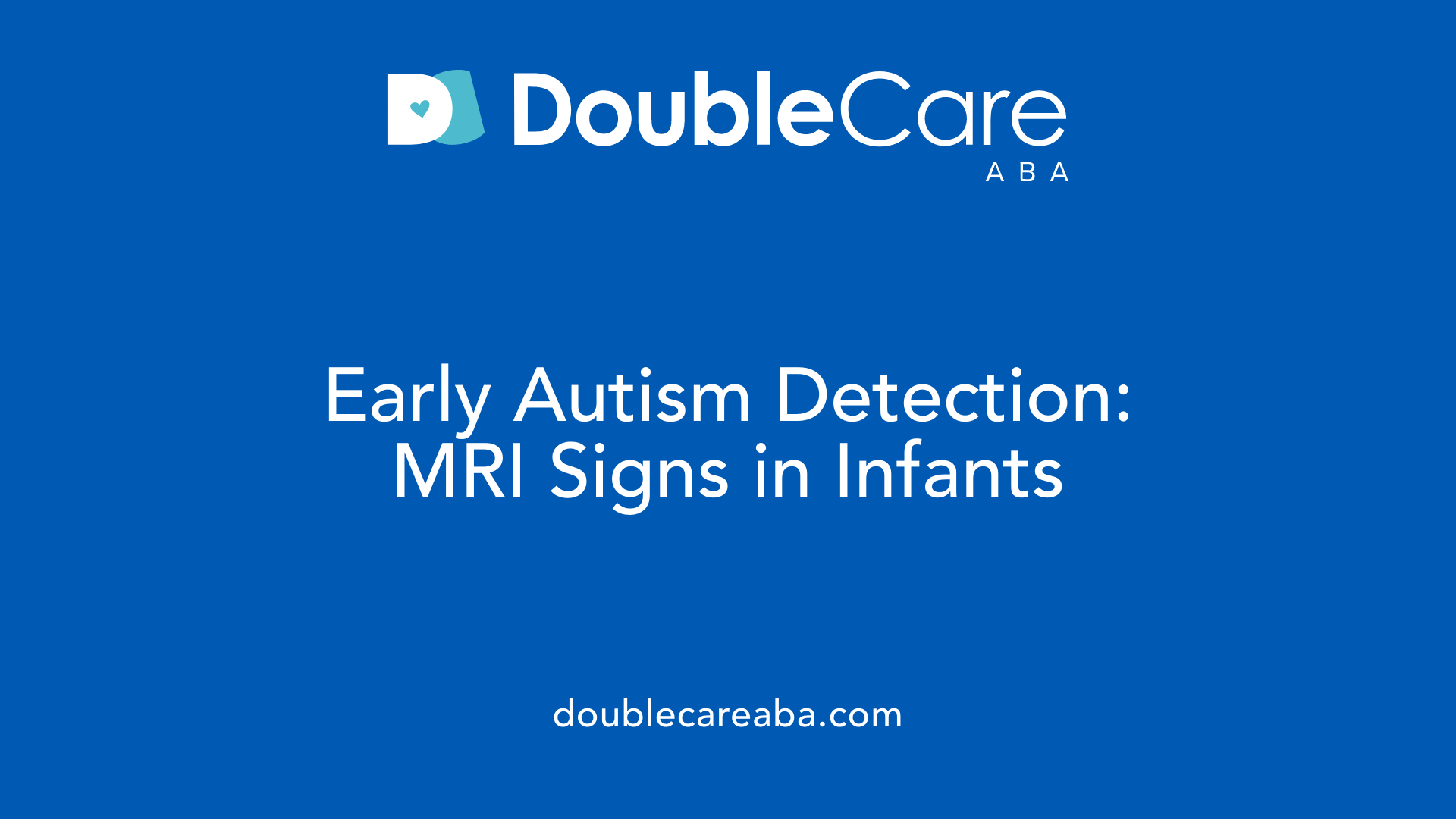Can MRI Scans Reveal Autism? Exploring the Science Behind the Images
Magnetic resonance imaging (MRI) has long been a tool for examining brain structure and function. Recent advances in neuroimaging combined with machine learning have opened promising avenues toward identifying brain markers linked to autism spectrum disorder (ASD). But can autism truly be seen on an MRI scan? This article delves into the current science behind MRI's role in autism diagnosis, the challenges it faces, and its potential to transform early detection and personalized treatment.
Structural MRI and Brain Morphology in ASD

Can structural MRI detect autism-related brain changes?
Structural MRI (sMRI) can reveal morphological anomalies in several brain regions linked to autism spectrum disorder (ASD). These include differences in cortical thickness, surface area, curvature, and volume when compared to typically developing individuals. Such imaging differences provide important clues to brain alterations associated with ASD.
Which brain areas show alterations in ASD?
Certain brain regions consistently show structural differences in individuals with ASD. Key areas affected include the Middle Temporal Gyrus, Transverse Temporal Gyrus, Frontal Pole, Rostral Anterior Cingulate, and Superior Temporal Gyrus. These regions are involved in language processing, social cognition, and executive functions, which are often impacted in ASD.
How do cortical features differentiate ASD from typical development?
Cortical features such as thickness, surface area, curvature, and volume are quantifiable with sMRI and differ significantly between ASD and neurotypical individuals. For example, increased or decreased cortical thickness in language-related areas can indicate atypical brain development characteristic of ASD. These measurements help classify and understand the brain's developmental patterns in autism.
How do neuro-atlases and personalized maps aid diagnosis?
Researchers build neuro-atlases derived from morphological markers obtained via sMRI to provide a comprehensive map of brain structure variations in ASD. These atlases allow for comparison across individuals and facilitate creation of personalized diagnostic maps. Personalized maps highlight specific brain regions affected in an individual, guiding tailored interventions and improving diagnostic precision.
| Aspect | Description | Example Brain Regions |
|---|---|---|
| Morphological Anomalies | Structural differences observed in ASD via sMRI | Middle Temporal Gyrus, Frontal Pole |
| Cortical Features Used | Thickness, surface area, curvature, volume | Superior Temporal Gyrus, Rostral Anterior Cingulate |
| Diagnostic Tools | Neuro-atlases and personalized maps derived from morphological features | Customized brain maps per individual |
In summary, structural MRI is a valuable, non-invasive tool for detecting autism-related brain changes by analyzing cortical morphology and region-specific alterations. These imaging advances support improved ASD characterization and personalized clinical care.
Early Detection of Autism Through MRI in Infants

Can MRI detect autism early in infants before symptoms appear?
MRI can identify early brain changes in infants at high risk for ASD, such as cortical surface area expansion and brain overgrowth occurring between 6 to 24 months of age. These physiological changes may precede observable behavioral symptoms of autism, providing opportunities for earlier diagnosis and intervention.
Studies have shown that brain overgrowth and cortical surface area expansion often start between 6 to 12 months and continue through 24 months in infants who later develop ASD. This period coincides with the emergence of autistic behaviors, suggesting that MRI can reveal neurological markers ahead of symptomatic diagnosis.
Longitudinal MRI studies with both high-risk and low-risk infants have been crucial in mapping these developmental trajectories. For example, analyses comparing infants from both groups found distinct patterns of brain morphology changes that distinguish those likely to develop ASD.
By detecting these early indicators, MRI holds significant potential to improve early diagnosis and personalize intervention strategies. Early intervention could be tailored to the individual brain development profiles of infants, possibly reducing long-term impacts of ASD.
This early neuroimaging approach complements behavioral assessments and opens pathways for non-invasive monitoring of high-risk infants, making it a promising frontier in ASD research and clinical practice.
Machine Learning Enhances MRI-Based Autism Diagnosis

How do machine learning models help classify autism from MRI data?
Machine learning techniques, including Artificial Neural Networks (ANNs) and Support Vector Machines (SVMs), analyze complex MRI-derived features to distinguish individuals with autism spectrum disorder (ASD) from typically developing (TD) individuals. These models evaluate variations in cortical characteristics such as thickness, surface area, curvature, and texture across key brain regions implicated in ASD.
By extracting and processing these detailed morphometric and texture markers—often from subcortical structures like the hippocampus and amygdala, as well as cortical areas like the frontal pole and temporal gyri—machine learning algorithms achieve high accuracy in classification tasks. For example, ANNs have been reported to reach classification accuracies above 80% in distinguishing ASD from control groups, particularly in children aged 6 to 15 years.
Addressing heterogeneity of ASD through feature selection and model optimization
ASD presents considerable heterogeneity in its neurological manifestations, posing challenges for reliable classification. To tackle this, feature selection methods identify the most informative MRI biomarkers that consistently differentiate ASD cases. Optimizing model parameters further enhances the precision and robustness of diagnostic predictions, ensuring the models can generalize well across varied populations.
These approaches enable the development of personalized neuro-atlases, which map affected brain regions in individual ASD cases, paving the way for tailored interventions. Through this integration of advanced neuroimaging and machine learning, non-invasive early detection and precise ASD diagnosis are becoming increasingly feasible.
Synaptic Density Insights: PET Scans Complement MRI Findings
Measurements of Synaptic Density in Living Autistic Adults
Recent advances have enabled the direct measurement of synaptic density in the brains of living autistic adults using positron emission tomography (PET) scans. A groundbreaking study employed a novel radiotracer, 11C-UCB-J, developed at the Yale PET Center. This tracer binds specifically to synaptic vesicle glycoprotein 2A (SV2A), allowing precise visualization and quantification of synapses, the critical junctions where neurons communicate.
Correlation Between Lower Synaptic Density and Autistic Traits
The study revealed that individuals with autism spectrum disorder (ASD) exhibit approximately 17% lower synaptic density throughout the brain compared to neurotypical controls. Notably, this reduction in synaptic connections strongly correlates with heightened autistic traits, such as difficulties with social communication and the presence of repetitive behaviors. These findings suggest that synaptic deficits may underlie some of the core behavioral features of autism.
Novel Radiotracer 11C-UCB-J
The development and utilization of 11C-UCB-J mark a significant advancement in neuroimaging, as prior research on synaptic differences largely relied on indirect methods, such as animal models or post-mortem brain analyses. This radiotracer enables researchers to explore synapse density in vivo in humans, offering new opportunities to investigate the biological mechanisms of ASD more accurately and non-invasively.
Implications for Understanding Autism Mechanisms
These PET imaging results complement structural MRI findings by providing a direct measure of synaptic health and offer promising biological markers that could refine the diagnosis of autism. Understanding synaptic density variations holds potential for developing targeted treatments and personalized interventions. Future research aims to extend these findings by studying synaptic changes in adolescents with ASD and exploring alternative, less costly imaging technologies for broader clinical use.
Functional MRI and Brain Activity Patterns in ASD
Brain responses to biological motion and sensory stimuli
Functional MRI has allowed researchers to observe how individuals with autism spectrum disorder (ASD) respond to social cues like biological motion—movements that signal social interactions. Studies have shown that brain regions involved in recognizing these motions display varied activation levels in people with ASD compared to neurotypical individuals. Additionally, sensory processing areas in the brain exhibit increased or sustained activation, reflecting challenges in habituating to repeated stimuli.
Differences in neural network activity and connectivity
Children and adults with ASD often show atypical neural activation patterns and altered connectivity within key brain networks. For instance, networks related to social cognition and sensory integration may function differently, leading to the sensory sensitivities and social difficulties characteristic of ASD. These changes are detectable via fMRI and contribute valuable insights into the heterogeneity of the disorder.
Usage of fMRI to study sensory processing and social brain networks
fMRI is instrumental in mapping how sensory and social brain networks operate in ASD. By examining brain responses to biological motion and other social stimuli, researchers can identify neural markers associated with specific behavioral traits. This enhanced understanding assists in identifying subtypes of ASD and tailoring intervention strategies accordingly.
Relevance for behavioral intervention planning
Critically, pre-treatment fMRI scans measuring brain responses to biological motion have been linked to individuals’ outcomes in behavioral therapies. This imaging approach offers predictive potential—helping clinicians select the most effective social or behavioral interventions for each individual with autism. Moreover, ongoing research is exploring ways to modulate brain activity, such as with oxytocin treatment or magnetic stimulation, to boost therapy effectiveness and personalize care plans.
Limitations and Clinical Utility of Routine MRI in Autism Diagnosis
Prevalence of abnormal brain MRI findings in children with ASD
Studies have found that significant abnormalities on brain MRI are identified in approximately 7.2% of children diagnosed with autism spectrum disorder (ASD). These abnormalities include white matter signal changes, volume loss, cortical heterotopia, and optic atrophy. Such findings are relatively rare when considering ASD alone.
Incidental findings versus diagnostic abnormalities
Around 22% of MRI scans in children with ASD reveal incidental, non-diagnostic findings like sinus opacification, perivascular spaces, and cysts. These incidental abnormalities do not correlate with ASD symptoms and generally do not have clinical significance for autism diagnosis.
Recommendations against routine MRI without neurological symptoms
Given the low prevalence of diagnostically significant abnormalities and the frequent occurrence of incidental findings, routine brain MRI is not recommended for all children with ASD. This position aligns with guidelines from pediatric and neurology authorities, which advise reserving MRI for cases presenting additional neurological symptoms or signs.
Relationship between MRI abnormalities and neurological/metabolic conditions
MRI abnormalities are strongly associated with abnormal neurological examinations (odds ratio 33.1) and with identified genetic or metabolic disorders (odds ratio 20). This suggests that when neurological or metabolic issues accompany ASD, MRI may provide meaningful diagnostic information. However, isolated ASD without other clinical indications rarely corresponds with notable MRI changes.
Is routine brain MRI recommended for all children with autism?
Significant brain MRI abnormalities occur in a small percentage of children with ASD, often linked to abnormal neurological examinations or genetic/metabolic abnormalities. Incidental findings are commonly observed but do not diagnose autism. Hence, routine brain MRI is not recommended in the absence of neurological or clinical signs, consistent with professional guidelines.
Advanced Neuroimaging Biomarkers: Volumetric and Diffusion MRI
Which 3D volumetric features in subcortical and cortical brain structures are linked to ASD?
Recent neuroimaging studies utilize 3D volumetric features extracted from MRI scans to identify morphometric differences in individuals with autism spectrum disorder (ASD). Key subcortical structures assessed include the hippocampus, amygdala, nucleus accumbens, and corpus callosum, alongside various cortical regions. These features are derived using geometric and texture descriptors that capture brain morphology nuances. Notably, enlarged volumes have been observed in the amygdala and total cerebral volume in children aged 2 to 5 years with ASD, findings that correlate with social and behavioral impairments.
What are the diffusion tensor imaging (DTI) findings on white matter connectivity abnormalities in ASD?
Diffusion tensor imaging (DTI) reveals characteristic abnormalities in white matter connectivity among individuals with ASD. Measures such as fractional anisotropy (FA) and mean diffusivity (MD) demonstrate altered developmental trajectories starting as early as six months of age. These abnormalities reflect atypical microstructural integrity of white matter pathways, potentially underlying communication difficulties between different brain regions essential for social interaction and cognition.
How do enlarged amygdala and brain volume relate to behavioral deficits in ASD?
Enlargement of the amygdala and overall brain volume during early childhood are consistently associated with behavioral and social deficits in autism. The amygdala plays a critical role in processing emotions and social signals, so its enlargement may contribute to the core social challenges experienced by individuals with ASD. Enlarged brain volume often follows a pattern of early neural overgrowth, succeeded by regression in volume and connectivity, paralleling the emergence and evolution of autistic behaviors.
What altered brain connectivity patterns are observed over development in ASD?
Functional MRI studies identify altered connectivity patterns within brain networks crucial for social and language functions, including the default mode network and language-related circuits. Infants and children at high risk for ASD exhibit increased connectivity in sensory brain regions. Additionally, difficulties habituating to sensory stimuli have been observed, with neural activation persisting longer than typical. These connectivity changes appear dynamic, reflecting the heterogeneous and evolving nature of autism across development.
| MRI Modality | Brain Features Assessed | Autism-Related Findings |
|---|---|---|
| Structural MRI | 3D volumetric and texture features | Enlarged amygdala and cerebral volume linked to social deficits |
| Diffusion Tensor Imaging | White matter fractional anisotropy | Abnormal developmental trajectories and compromised connectivity |
| Functional MRI | Brain network connectivity | Altered sensory and social function network activity |
From MRI Findings to Behavioral Therapy: Bridging Neuroscience and Applied Behavior Analysis (ABA)
What is Applied Behavior Analysis (ABA) therapy and how does it help individuals with autism?
Applied Behavior Analysis (ABA) therapy is a well-established, evidence-based approach that utilizes behavioral principles to improve communication, social, and adaptive skills in individuals with autism spectrum disorder (ASD). The therapy is highly structured and individualized, using techniques such as positive reinforcement and systematic behavior analysis. Its primary goal is to enhance everyday functioning and promote greater independence, adapting interventions based on each person's unique strengths and challenges.
Who provides ABA therapy and what qualifications do these professionals have?
ABA therapy is typically delivered by trained and certified professionals including Board Certified Behavior Analysts (BCBAs) and Registered Behavior Technicians (RBTs). These specialists undergo rigorous education and supervised experience, followed by certification examinations to ensure their expertise. Their training equips them to conduct thorough behavioral assessments and design effective intervention plans tailored to individual needs.
What are the typical components or techniques used in ABA therapy for autism?
ABA therapy incorporates a variety of methods to support skill acquisition and reduce challenging behaviors. Key techniques include:
- Positive reinforcement: Encouraging desired behaviors by rewarding them.
- Discrete Trial Training (DTT): Breaking skills into small, teachable steps with clear instructions.
- Modeling: Demonstrating behaviors for the individual to imitate.
- Prompting and fading: Providing cues initially and gradually reducing them.
- Task analysis: Breaking down complex tasks into simpler parts.
- Natural environment teaching: Using everyday settings for skill practice. Progress is tracked through data-driven monitoring to refine therapy and celebrate successes.
Role of Neuroimaging in Personalizing Interventions
Advances in neuroimaging, such as MRI, have enhanced our understanding of the neural basis of ASD. Functional and structural MRI studies reveal brain region differences and connectivity patterns that vary among individuals, reflecting the spectrum's heterogeneity. These insights enable the development of personalized treatment maps that identify affected brain regions in a given individual. For example, MRI measures of brain responses to biological motion can predict how well someone might benefit from specific social or behavioral interventions, including ABA.
This merging of neuroscience and ABA therapy holds promise for tailoring treatment strategies more precisely, potentially improving outcomes by aligning behavioral techniques with individual neurobiological profiles.
Supporting Families and Caregivers in Therapy Implementation
The success of ABA therapy heavily relies on active involvement from families and caregivers. Neuroimaging-informed insights support therapists in educating families about their child's unique brain differences, fostering understanding and cooperation.
Training and resources empower caregivers to embed ABA strategies into daily routines, maximizing skill generalization. Collaborative communication between professionals and families ensures that therapy is consistent, meaningful, and adapted as individuals progress. This partnership enhances not only therapy effectiveness but also overall quality of life for children with ASD and their families.
Monitoring Progress in ABA Therapy: Data-Driven Approaches

How is the progress of an individual undergoing ABA therapy measured?
Progress in Applied Behavior Analysis (ABA) therapy is gauged through continuous and systematic data collection focusing on the targeted behaviors of the individual. Behavior tracking involves documenting frequency, intensity, and duration of specific actions to monitor improvements or identify challenges as therapy unfolds.
Standardized assessment tools play a critical role in complementing direct behavior observations. Instruments like the Parent Observation of Progress-Child (POP-C), Vineland Adaptive Behavior Scales, Third Edition (Vineland-3), and the Verbal Behavior Milestones Assessment and Placement Program (VB-MAPP) provide structured evaluations of social skills, communication, and adaptive functioning.
The combined use of real-time behavior tracking and standardized measures allows therapists to obtain a comprehensive view of the individual's development across therapy sessions. This evidence-based approach facilitates timely adjustments to intervention plans, ensuring therapeutic strategies remain responsive to the individual’s evolving needs and maximize treatment efficacy.
Controversies and Challenges of ABA Therapy in Autism
What are some challenges and criticisms associated with ABA therapy for autism?
While Applied Behavior Analysis (ABA) therapy is recognized for its effectiveness in improving skills in individuals with autism, it faces significant criticisms and challenges. One major concern is the intensity of the therapy, which often requires a demanding time commitment from children and families. This rigorous schedule can lead to emotional stress, impacting the child's well-being.
Critics also highlight that ABA therapy's strong emphasis on compliance and behavior modification may overshadow the importance of respecting neurodiversity. There is concern that therapy sometimes focuses on suppressing natural autistic behaviors instead of fostering the individual's unique identity and autonomy.
In response, alternative and person-centered therapies are emerging. These approaches prioritize acceptance of autistic traits and support individualized goals that honor the person’s preferences and strengths. They aim to reduce the emotional burden often associated with traditional ABA interventions.
Balancing the evident benefits of ABA with these risks and criticisms is crucial. Families and clinicians are increasingly advocating for more flexible, respectful, and tailored treatment plans that address the holistic needs of autistic individuals, ensuring therapy supports their overall development and well-being.
Supporting Families and Caregivers in ABA and Neuroimaging-Based Autism Care

How can families and caregivers support individuals receiving ABA therapy?
Families play a crucial role in the success of Applied Behavior Analysis (ABA) therapy for individuals with autism spectrum disorder (ASD). Their involvement ensures that the skills learned during therapy sessions transfer effectively into real-world settings.
Importance of family involvement in therapy success
When families actively participate, they collaborate with professionals to create consistent learning environments. This partnership helps in reinforcing behavioral strategies and promotes generalization of skills across various contexts.
Training families to reinforce skills at home
Parent training programs empower caregivers with the knowledge and techniques necessary to support therapy goals. Through guidance on specific interventions, families learn to apply behavioral approaches during daily activities, strengthening the therapeutic impact.
Addressing barriers to engagement and resource access
Challenges such as caregiver stress, limited access to resources, and time constraints can hinder effective participation. Recognizing and addressing these barriers through community support and flexible service delivery models enhances family engagement.
Empowering caregivers to advocate and participate
Educating families about their rights and available services enables them to advocate effectively for their loved ones. Engaged caregivers contribute to individualized treatment planning, ensuring that care aligns with the specific needs of the individual with ASD.
By fostering collaboration, providing training, removing barriers, and empowering families, ABA and neuroimaging-based interventions become more impactful, leading to improved outcomes for individuals with autism.
The Future of Autism Diagnosis and Treatment: Toward Personalized Brain-Based Care
MRI technology, combined with cutting-edge machine learning and functional imaging, offers profound insights into the brain differences underlying autism spectrum disorder. While routine MRI is not currently recommended as a universal diagnostic tool, its capacity for early detection and tailoring interventions is rapidly evolving. Coupling neuroimaging findings with evidence-based therapies such as Applied Behavior Analysis allows for increasingly personalized treatment approaches. The challenges ahead include addressing the heterogeneity of autism, refining imaging techniques, and ensuring therapies respect individuality and neurodiversity. With ongoing research, MRI might one day move from a diagnostic adjunct to a cornerstone of precision autism care, empowering families and clinicians to optimize outcomes from infancy through adulthood.
References
- The Role of Structure MRI in Diagnosing Autism - PMC
- Using MRI to Diagnose Autism Spectrum Disorder
- A Key Brain Difference Linked to Autism Is Found for the First ...
- Can brain scans help personalize autism therapies and ...
- Yield of brain MRI in children with autism spectrum disorder
- Brain Development - Neuroimaging in Autism
- Emerging behavioral and neuroimaging biomarkers for ...














